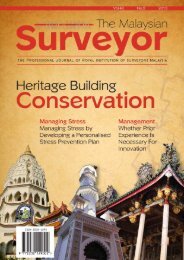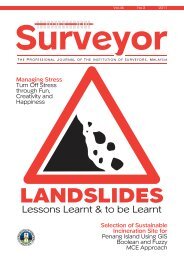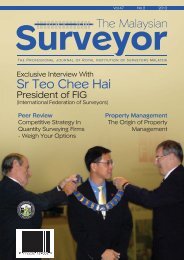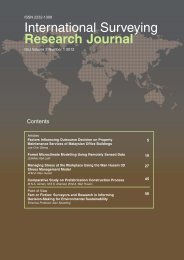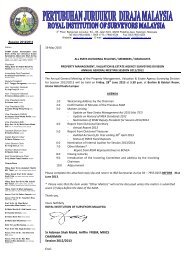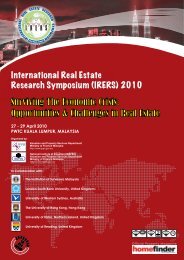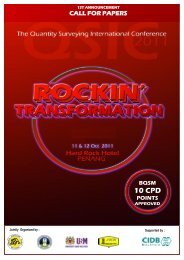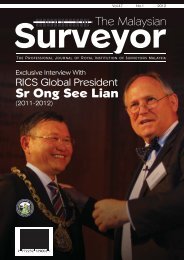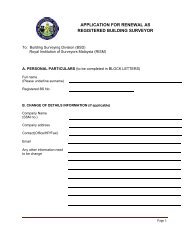Full 46.1 - Royal Institution of Surveyors Malaysia
Full 46.1 - Royal Institution of Surveyors Malaysia
Full 46.1 - Royal Institution of Surveyors Malaysia
Create successful ePaper yourself
Turn your PDF publications into a flip-book with our unique Google optimized e-Paper software.
THE MALAYSIAN SURVEYOR | Vol.46 | No.1 | 2011<br />
The method used to gain data is through interviews. The<br />
interviews were conducted through structured questions<br />
in relation to the research’s objectives. The questions<br />
were divided into two sections: the first question relates<br />
to problems in maintaining heritage buildings and the<br />
second, on the significance <strong>of</strong> maintaining heritage<br />
buildings. The other questions consist <strong>of</strong> issues regarding<br />
the guidelines in maintaining heritage buildings, the<br />
availability <strong>of</strong> resources (manpower and materials), the<br />
methods and procedures <strong>of</strong><br />
maintenance work applied,<br />
the cost involved for<br />
maintenance work and the<br />
interviewee’s personal<br />
opinion regarding factors<br />
that play a key role towards<br />
the importance <strong>of</strong><br />
maintaining heritage<br />
buildings.<br />
Other than interviews, other<br />
data recorded such as<br />
pictures and drawings were<br />
also obtained from the<br />
interviewees. It took two<br />
and a half months to complete these interviews and data<br />
collection. The measurements <strong>of</strong> the findings are based<br />
on the agreement, clarity and amount.<br />
Case Studies<br />
Case studies help to classify and obtain concrete<br />
information regarding maintenance work <strong>of</strong> heritage<br />
buildings based on the current work executed by actual<br />
maintenance management. It also provides<br />
theoretical/conceptual information on how an old<br />
…tourism is the second most<br />
important sector in <strong>Malaysia</strong>’s<br />
economy, with 22.5 million<br />
foreign tourists visiting<br />
<strong>Malaysia</strong> in 2008, bringing in<br />
RM49.1 billion (USD16.2<br />
billion) in revenue.<br />
building is maintained. For this study, a total <strong>of</strong> six<br />
heritage buildings under Category 1 were selected as the<br />
case study. These buildings are located in the primary<br />
zone consisting <strong>of</strong> different types <strong>of</strong> building functions. As<br />
stated by KLCH (2009) in the Draft Kuala Lumpur City<br />
Plan 2020, buildings that fall under Category 1 are<br />
buildings that were previously gazetted under National<br />
Heritage Act 2005 and fall under the jurisdiction <strong>of</strong> the<br />
Commissioner for Heritage. Meanwhile, buildings located<br />
in the primary zone indicate<br />
that buildings <strong>of</strong> heritage<br />
characteristics and<br />
development are strictly<br />
controlled to maintain its<br />
existing environment and to<br />
prevent alteration works <strong>of</strong><br />
non-gazetted buildings from<br />
affecting the heritage<br />
buildings.<br />
As shown in Figure 2, these<br />
buildings are all British<br />
Colonial buildings with<br />
Mogul architectural style<br />
(also known as Moorish or<br />
Indian Muslim style), Tudor, Neo-Classical and Neo-Gothic<br />
influence. In order to retain the individual building<br />
anonymity, they are designated as Building A, Building B,<br />
Building C, Building D, Building E and Building F.<br />
Interpretation <strong>of</strong> Results<br />
The interview was carried out on six different types <strong>of</strong><br />
building functions as shown in Figure 2. The respondents<br />
for these case studies consist <strong>of</strong> supervisors, technician<br />
coordinators, mechanical engineers, building manager<br />
Figure 2: Six Different Types <strong>of</strong> Building Function for the Case Studies<br />
Building A Building B Building C<br />
Building D Building E Building F<br />
34



